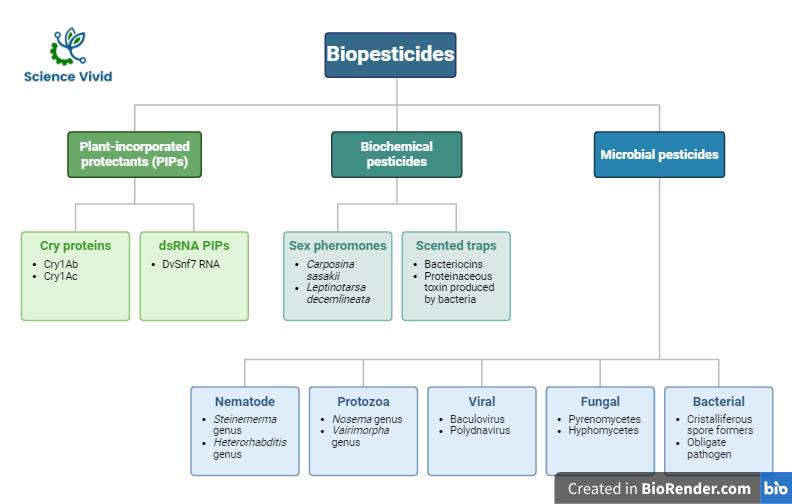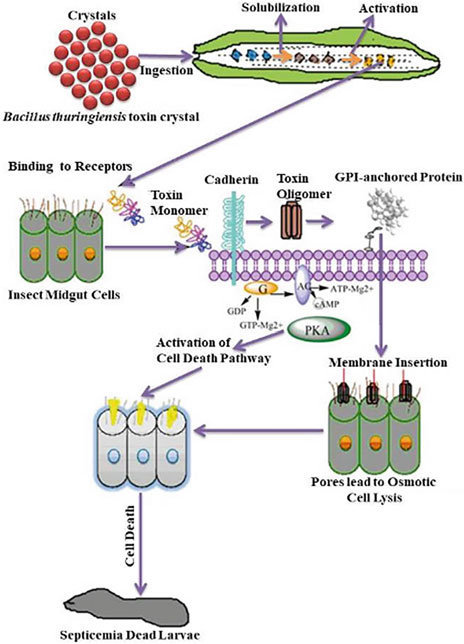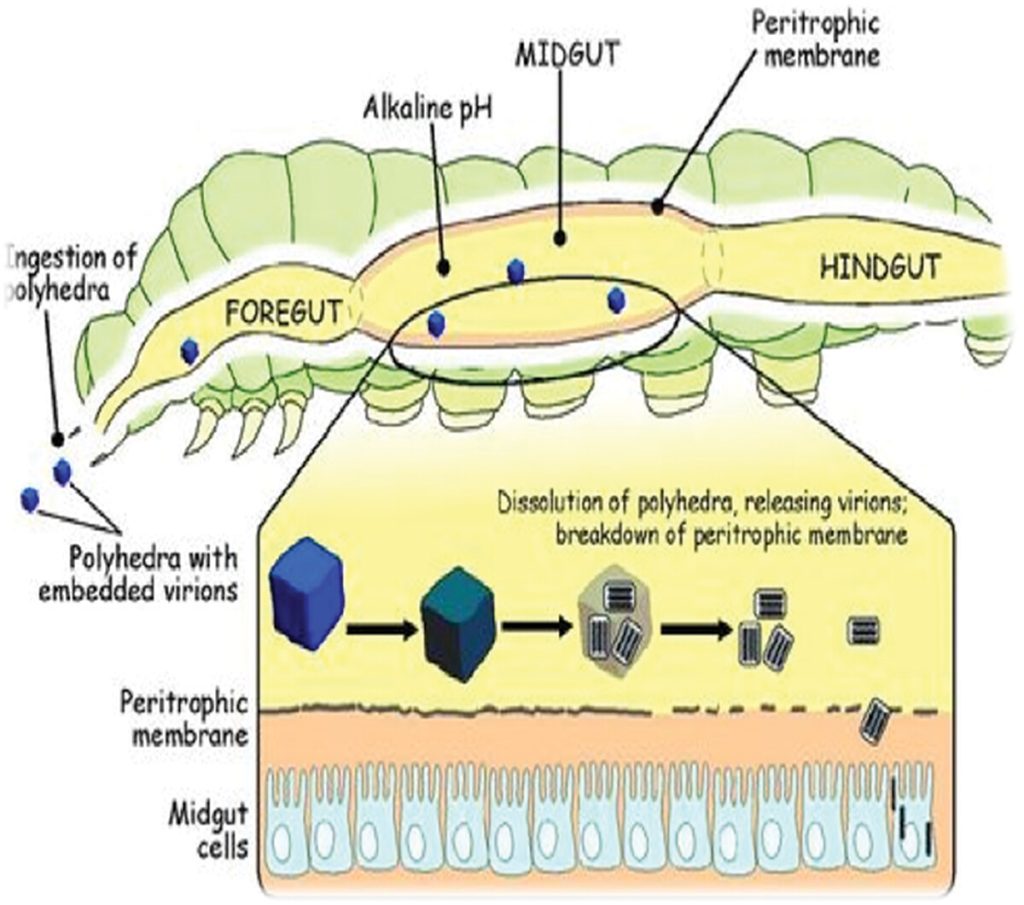Introduction:
Biopesticides are certain types of natural, biologically occurring pesticides that are used to control various agricultural pests and pathogens. It is derived from such natural materials as animals, plants, certain minerals, and microorganisms such as bacteria, cyanobacteria, and microalgae. It is a biological agent, class of pesticides that tend to pose fewer risks than conventional chemicals which means less pollution by suppressing the growth and proliferation of pests through diverse mechanisms of action.
Classification:
Biochemical pesticides
Naturally occurring substances also known as herbal pesticides are secondary metabolites that control or inactivate pests. Extract from seed kernel, lemongrass, neem, essentials oils from neem oil, canola, and extract of bark and leaves from some valuable plants are generally used as biochemical pesticides that uses non-toxic way to manage pests. In addition, biochemical pesticides contain chemicals such as insect sex pheromones and other aromatic plant extracts that lure insect pests to traps while also preventing matting.
Microbial biopesticides
Microbial pesticides are environment-friendly and host specific that consist of a microorganism (e.g., a bacterium, fungus, virus or protozoan) are the largest group of pest-specific, broad-spectrum biopesticides for the management of pests including lepidopterans, coleopterans and dipterans. Bacillus thuringiensis (Bt) commonly found in soil is a naturally occurring bacterium produce protein toxins such as Cry proteins or δ-endotoxins that are lethal to larvae of flies and mosquitoes.

Fig: Classification of biopesticides
There are at least 3000 naturally occurring insect- specific microorganisms, 100 of which are insecticidal.
Bacterial biopesticides
Crystalliferous spore formers (Bacillus thuringiensis), Obligate pathogens (Bacillus papiliae), Potential pathogens (Serratia marcesens), Facultative pathogens (Pseudomonas aeruginosa)
Bacillus thuringiensis (Bt) are gram-positive spore-forming bacteria with entomopathogenic properties with activity against insects of different orders – Lepidoptera, Coleoptera, Diptera and also against other invertebrates such as nematodes.
During the during the sporulation phase as parasporal crystals, Bt produce insecticidal proteins which is predominantly composed of one or more proteins (Cry and Cyt toxins), also called δ-endotoxins. Their primary action of these protein is to lyse midgut epithelial cells by inserting into the target membrane and forming pores.

Reference: DOI: 10.1007/978-981-15-4439-2_1
Fig: Mode of action of Bacillus thuringiensis Cry and Cyt toxins and their potential for insect control
Viral biopesticides
Baculoviruses are a family of naturally target specific virus which are known to infect and destroy insects, some related arthropods, and number of important plant pests such as lepidopterous pests of cotton, rice and vegetables. Mainly, Nucleopolyhedrovirus (NPV)and Granulovirus (GVs) are the two groups of baculoviruses that are used as biopesticides. It needs to be ingested by the larvae to initiate infection. Following ingestion, they enter the insect’s body via the midgut then spread throughout the body.
Moreover, the infection often spreads to the haemocoel and then to essential organs and tissues, particularly fat bodies. However, they do not produce any toxins or metabolites which could be a concern regarding human health.

Reference: https://doi.org/10.1080/23311932.2023.2254139
Fig: The mode of action of nucleopolyhedrovirus (NPV) on insect host
Fungal biopesticides
Entomopathogenic fungi are a group of fungi such as Laboulbeniales, Pyrenomycetes, Hyphomycetes, Zygomycetes that kill an insect by attacking and infecting its insect host.
Protozoan biopesticides
Microsporidians, also known as Entomopathogenic protozoans, are a wide-ranging group of organisms that attack invertebrates, especially insects, and are typically host specific and slow acting, resulting in persistent infections. The infectious stage of the protozoan is the spore, which must be consumed by the insect host for pathogenicity to occur. The spore germinates in the midgut, and sporoplasm is discharged, entering target cells and infecting the host. The infection causes the insect host to feed less, have less vigor, fecundity, and live shorter.
Plant-Incorporated Protectants (PIPs)
These are the pesticidal substances having pesticidal actions that is produced by genetically modified crops (GMOs). Genetic material is introduced into the plants that will produce such pesticidal substances to offer resistance against pests and such plants are called Plant-Incorporated-Protectants (PIPs).
Benefits of Biopesticides:
- Biopesticides are biodegradable and manufactured by naturally occurring raw materials in a sustainable and environmentally responsible manner.
- They are non-toxic and are of minimal risk to human health, and decompose quickly and also has no negative impact on water and ground water.
- They more environmentally friendly and increase the yielding impact and improve crop quality by enhancing the soil microflora, which eventually aid in the increase of agricultural production.
- In contrast to the conventional method of pesticides, biopesticides work primarily in minimal doses and doesn’t affect the wide variety of organisms, such as animals, birds, and insects. It always affects the targeted organism and pests closely related to it.
Disadvantage of Biopesticides:
- In comparison to conventional pesticides, biopesticides show slower rate of action and often a lower efficacy and shorter persistence. Thus, it seems unsuitable of a pest that show immediate threat to a crop.
- One should have greater level of knowledge to use bio-pesticides effectively.
- They have a short shelf life and some biopesticides show limited effectiveness under certain environmental conditions.
